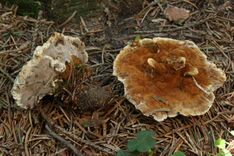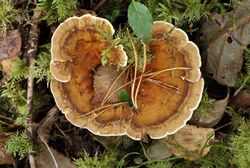Biology:Onnia tomentosa
| Onnia tomentosa | |
|---|---|

| |
| Scientific classification | |
| Kingdom: | |
| Division: | |
| Class: | |
| Order: | |
| Family: | |
| Genus: | |
| Species: | O. tomentosa
|
| Binomial name | |
| Onnia tomentosa (Fr.) P.Karst. (1889)
| |
| Synonyms | |
| |
Onnia tomentosa is a species of fungus in the family Hymenochaetaceae commonly known as the woolly velvet polypore. It is frequently found in coniferous forests at higher altitudes, often growing in large groups, rather rare at lower altitudes. It is a plant pathogen, and causes tomentosus root rot, primarily in spruce.[1] It was formerly known as Inonotus tomentosum (Fr.) Teng until molecular phylogenetic analysis led to major revisions in the classification of the Hymenochaetaceae.[2]
Description
The cap is flat when young, with a blunt, rounded and yellowish-white margin, later with a slightly depressed centre and contoured in a wave pattern towards the rim, which has a rather sharp edge when old. It is covered in felt that is grey when young and rusty brown when old, up to 10 cm (3 7⁄8 in) in diameter. The stem, if present, is short and thick,[3] and dark brown to near-black; the caps may also grow directly on the base of a tree.[3] The flesh is ochre brown under the cap surface,[citation needed] softer above, and hard and fibrous below.[3] The species is inedible.[4]
Most commercially important conifers in Canada, including white spruce, are attacked by Inonotus tomentosus (Fr.) Teng also known as Onnia tomentosa.[5] This fungus produces a white pocket rot commonly called Tomentosus root rot in both roots and butts of naturally seeded or planted conifers. White spruce and black spruce were found to be the two most susceptible species in an inoculation test in Saskatchewan,[6] and high losses to root rot, in large part due to I. tomentosus, affected white spruce plantations at Grand-Mère QC.[7] In white spruce plantations, mortality in groups of two or three trees usually occurs at about the age of 30–35 years,[8] but younger trees can also be killed.[9] Occasional trees as young as 10 years of age are infected.[10] Seventeen white spruce plantations 43–58 years old in Ontario incurred an average of 0.7% mortality annually over a 6-year study period.[9] Average accumulated mortality of dominant and codominant trees was 10.3% for all plantations in that study. Tomentosus root rot was found in more than half the stumps after clearcutting in a plantation at Searchmont, Ontario, but decay and stain had not yet reached stump height.[11]
Similar species
Coltricia perennis is similar, but has a weakly circularly zoned, bare cap. The flesh of the cap is stained uniformly. Other species of Coltricia and Phaeolus are also similar.[3]
References
- ↑ Ryvarden, Leif; Gilbertson, Robert L. (1986). North American Polypores. Oslo, Norway: Fungiflora. ISBN 0-945345-06-2.
- ↑ Wagner, T Fischer M. (2002). "Proceedings towards a natural classification of the worldwide taxa Phellinus s.l. and Inonotus s.l., and phylogenetic relationships of allied genera". Mycologia 94 (6): 998–1016. doi:10.2307/3761866. PMID 21156572.
- ↑ 3.0 3.1 3.2 3.3 Trudell, Steve; Ammirati, Joe (2009) (in en). Mushrooms of the Pacific Northwest. Timber Press Field Guides. Portland, OR: Timber Press. pp. 261–262. ISBN 978-0-88192-935-5. https://books.google.com/books?id=WevHvt6Tr8kC.
- ↑ Miller Jr., Orson K.; Miller, Hope H. (2006). North American Mushrooms: A Field Guide to Edible and Inedible Fungi. Guilford, CN: FalconGuides. pp. 415. ISBN 978-0-7627-3109-1.
- ↑ Whitney, R.D. 1978. Polyporus tomentosus root and butt rot of trees in Canada. p. 283–297 in Dimitri, L. (Ed.), Proc. 5th Internat. IUFRO Conf. on Problems of root and butt rot in conifers, Aug. 1978, Kassell. Germany.
- ↑ Whitney, R.D. 1964. Inoculation of eight Saskatchewan trees with Polyporus tomentosus. Can. Dep. For., Ottawa ON, Bi-mo. Res. Notes 28(4):24.
- ↑ Lachance, D. 1978. The effect of decay on growth rate in a white spruce plantation. For. Chron. 54(1):20–23.
- ↑ Whitney, R.D. 1977. Polyporus tomentosus root rot of conifers. Can. Dep. Environ., Can. For. Serv., Ottawa ON, For. Tech. Rep. 18. 12 p.
- ↑ 9.0 9.1 Whitney, R.D. 1993. Damage by Tomentosus root rot in white spruce plantations in Ontario, and the effects of thinning on the disease. For. Chron. 69(4):44.
- ↑ Whitney, R.D.; Timmer, V.R. 1983. Chlorosis in planted white spruce at Limestone Lake, Ontario. Can. Dep. Environ., Can. For. Serv., Sault Ste. Marie ON, Inf. Rep. O-X-346. 16 p.
- ↑ Whitney R.D. (1962). "Polyporus tomentosus Fr. as a major factor in stand-opening disease of white spruce". Can. J. Bot. 40: 1631–1658. doi:10.1139/b62-158.
Further reading
- E. Garnweidner. Mushrooms and Toadstools of Britain and Europe. Collins. 1994.
Wikidata ☰ Q7094397 entry
 |


